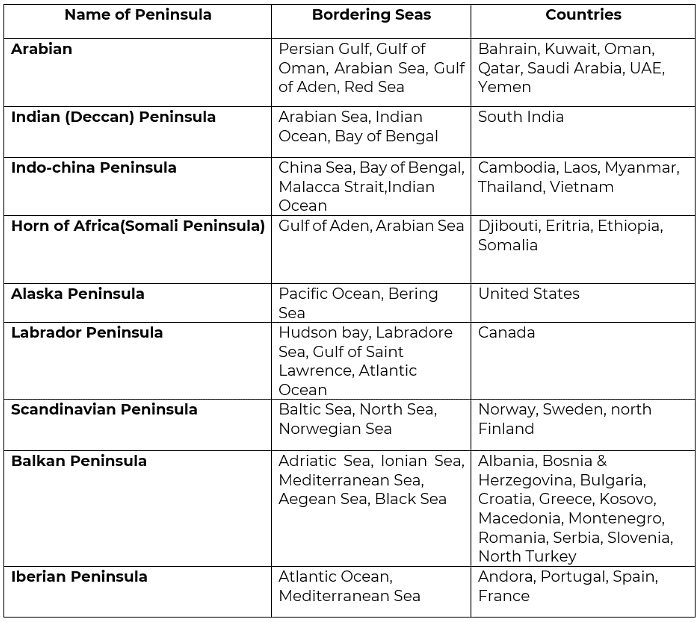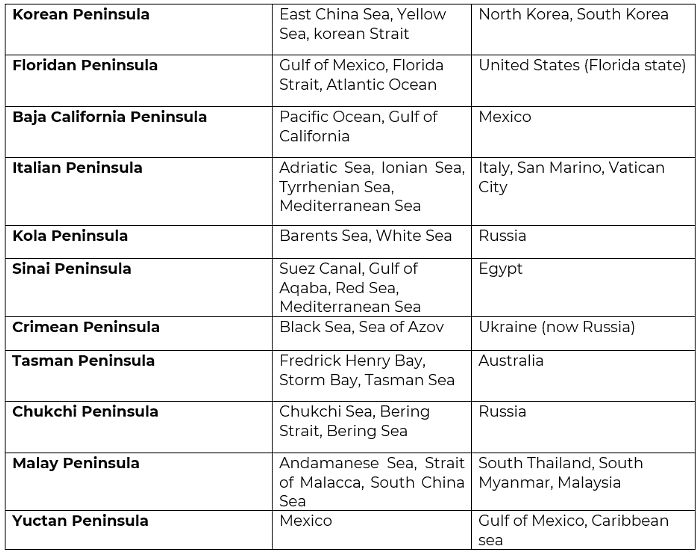Important Peninsulas in the World - UPSC PDF Download
Introduction
Peninsula – (paene “almost” and insula “island”) A peninsula is a landform surrounded by water on most of its border (three sides) while being connected to a mainland from which it extends. The surrounding water is usually understood to be continuous, though not necessarily named as a single body of water.
- Peninsulas are not always named as such; one can also be referred to as a headland, cape, island promontory, bill, point, fork, or spit.
- A river which courses through a very tight meander is also sometimes said to form a “peninsula” within the (almost closed) loop of water.
- Varying in sizes, they could range from the Arabian Peninsula, one of the largest peninsulas in the world to much smaller ones.
Important Peninsulas in the World
The Arabian Peninsula:
- A peninsula of Western Asia, it is situated in the Northeast of Africa on the Arabian plate. Being the largest peninsula on the earth, it features an area of 1,250,000 square miles.
- The peninsula consists of Yemen, Oman, Qatar, Bahrain, Kuwait, Saudi Arabia, UAE, and parts of Jordan and Iraq.
- The peninsula is believed to have formed by the drifting of the Red Sea. Hence, it is bordered by the Red Sea on the West and the Southwest, the Persian Gulf to the Northeast, and the Indian Ocean to the Southeast. It is connected to the Levant in the North.
- Largely unsuitable for agricultural activities, the peninsula holds geopolitical significance owing to its vast resources of oil and natural gas.
The (Indian) Deccan Peninsula:
- Surrounded by the Arabian Sea to the West, the Bay of Bengal to the east, and the Indian Ocean to the south, the Indian peninsula is the second largest peninsula in the world.
- It is located in the Southern part of central India.
- Comprising of the Eastern and Western Ghats, the peninsula is rich in biodiversity and is home to a tiger reserve of national importance.
- The climate in this region ranges from semi-arid to tropical type.
- It is inclusive of eight Indian states and the people largely indulge in agricultural practices.
The Indo-china Peninsula:
- Also known as Mainland Southeast Asia, it is the continental portion of Southeast Asia and lies east of India and south of China.
- The Indian Ocean bounds the region to the west and the Pacific Ocean to the east. Projecting southwards from the Asian continent, it features several mountain ranges like the Tibetan Plateau to the north.
- The peninsula includes Myanmar, Cambodia, Laos, Malaysia, Thailand, and Vietnam.
- Additionally, the southernmost part of the Indo-china peninsula protrudes to form the Malay Peninsula, which regions Southern Thailand and peninsular Malaysia.
The Horn of Africa:
- Large extension of land protruding from the Eastern edge of the African continent, the Horn of Africa is the fourth largest peninsula in the world.
- It comprises four countries of Djibouti, Ethiopia, Eritrea, and Somalia.
- Also called the Somali Peninsular, it is surrounded by the Gulf of Aden to the north, the Indian Ocean to the east and extends into the Arabian Sea for hundreds of miles.
- It hosts the highest number of reptiles, whereas the locals participate in livestock herding and export coffee and bananas.
The Alaska Peninsula:
- Separating the Pacific Ocean from the Bristol Bay, which is an arm of the Bering Sea, the peninsula extends about 497 miles to the Southwest from the mainland of Alaska and ends at the Aleutian Islands.
- The term ‘Alaska Peninsula’ denotes the Northwestern projection of the North American continent.
- It is surrounded by the Arctic Sea in the north, Bering Strait in the west, and the Pacific Sea to the south.
- Running along the length of the peninsula, the Aleutian Range is a highly active volcanic mountain range and is home to numerous wildlife refuges and national parks.
The Labrador Peninsula:
- The peninsula in Eastern Canada.
- It consists of the Canadian provinces of Newfoundland and Labrador and the province of Quebec.
- It is bound by the Hudson Bay to the west, the Hudson Strait to the north, the Labrador Sea to the East, and the Gulf of Saint Lawrence to the Southeast. It connects to the mainland in the Southwest only.
- The peninsula features river valleys, mountain ranges, and national parks. The peninsula, owing to being covered in the Canadian shield, has numerous lakes.
The Scandinavian Peninsula:
- A large promontory of northern Europe comprises Sweden, Norway, and the Northwestern area of Finland.
- Deriving its name from the cultural region of Denmark, Norway, and Sweden, the Scandinavian Peninsula is one of the largest peninsulas of Europe.
- It is bordered by the Barents Sea to the north, the Norwegian Sea to the west, the North Sea, and the Baltic Sea to the south.
- A quarter of the peninsula lies north of the Arctic Circle, the climates vary from tundra to subarctic with cool marine coastlines in the West.
The Balkan Peninsula:
- Rooting its name from the Balkans Mountain Range, the Balkan Peninsula is a geographical region in Southeastern Europe. It is neighbored by the Adriatic Sea on the northwest, the Ionian Sea on the southwest, the Aegean Sea on the south and southeast, and the Black Sea on the east and the northeast.
- It spreads across 181,000 square miles of area, without a well-defined northern boundary.
- It comprises Albania, Bosnia and Herzegovina, Bulgaria, Croatia, Greece, Kosovo, Macedonia, Montenegro, Romania, Serbia, Slovenia, and North Turkey.
The Iberian Peninsula:
- Also referred to as Iberia, the peninsula is located in southwestern Europe.
- It is principally divided between the Spanish and Portugal territory, but also includes Andorra and a small part of France as well as Gibraltar on its South coast.
- With an expanse of 225,000 square miles, it is the second-largest European peninsula, after the Scandinavian Peninsula.
- It is bordered by the Mediterranean Sea on the Southeast and East and by the Atlantic Ocean on the north, west, and southwest. It is in close proximity to the northwest African coast, separated by the Strait of Gibraltar and the Mediterranean Sea.
The Kamchatka Peninsula:
- The region is located in the Russian Far East.
- The eastern and the western Coastlines are made up by the Pacific Ocean and the Sea of Okhotsk, respectively.
- The region features the volcanoes of Kamchatka, which is recognized as a World Heritage Site by UNESCO.
- The region faces moderately cool summers and stormy winters. Collectively, the Kamchatka Peninsula, the Commander Islands, and the Karaginsky Island constitute the Kamchatka Krai of the Russian Federation.
Korean Peninsula
- Korea, or the Korean Peninsula, is a region in East Asia.
- The peninsula extends southwards for about 1,100 km (680 mi) from continental Asia into the Pacific Ocean and is surrounded by the Sea of Japan (East Sea) to the east and the Yellow Sea (West Sea) to the west, the Korea Strait connecting the two bodies of water.
- Since 1945 it has been divided into two parts which soon became the two sovereign states: North Korea and South Korea.
- Korea consists of the Korean Peninsula, Jeju Island, and several minor islands near the peninsula.
- Notable islands include Jeju Island, Ulleung Island, Dokdo.
- To the northwest, the Amnok River separates Korea from China, and to the northeast, the Duman River separates it from China and Russia.
Floridan Peninsula
Baja California Peninsula
- The Baja California Peninsula is a peninsula in Northwestern Mexico. It separates the Pacific Ocean from the Gulf of California.
- The peninsula extends 1,247 km from Mexicali, Baja California in the north to Cabo San Lucas, Baja California Sur in the south.
- baja california peninsula upsc
Italian Peninsula
- The Italian Peninsula, also known as the Italic Peninsula or the Apennine Peninsula, is a peninsula extending from the southern Alps in the north to the central Mediterranean Sea in the south.
Kola Peninsula
- The Kola Peninsula is a peninsula in the extreme northwest of Russia, and one of the largest peninsulas of Europe.
Sinai Peninsula
- The Sinai Peninsula, or simply Sinai is a peninsula in Egypt and the only part of the country located in Asia.
- Egypt’s Sinai Peninsula is a sparsely populated desert region between the Red Sea and the Mediterranean Sea.
Crimean Peninsula
- Crimea (or Tauric Peninsula) is a peninsula located on the northern coast of the Black Sea in Eastern Europe that is almost completely surrounded by both the Black Sea and the smaller Sea of Azov to the northeast.
- The Crimean peninsula is connected on the northwest to the mainland by the “Perekop Isthmus”, a 5-mile- (8-km-) wide strip of land that has been the site of numerous battles for the control of Crimea.
- The Crimean Peninsula was annexed by the Russian Federation in 2014 and since then has been administered as two Russian federal subjects – the Republic of Crimea and the federal city of Sevastopol.
Anatolian Peninsula
- Anatolia, also known as Asia Minor, is a large peninsula in Western Asia and the westernmost protrusion of the Asian continent.
- The region is bounded by the Turkish Straits to the northwest, the Black Sea to the north, the Armenian Highlands to the east, the Mediterranean Sea to the south, and the Aegean Sea to the west.
- The Sea of Marmara forms a connection between the Black and Aegean seas through the Bosporus and Dardanelles straits and separates Anatolia from Thrace on the Balkan peninsula of Southeast Europe.
Tasman Peninsula
- The Tasman Peninsula / Turrakana is a peninsula located in southeast Tasmania, Australia, approximately 75 km by the Arthur Highway, southeast of Hobart.
- The Tasman Peninsula / Turrakana lies south and west of Forestier Peninsula, to which it connects via an isthmus called Eaglehawk Neck.
Chukchi Peninsula
- The Chukchi Peninsula (also Chukotka Peninsula or Chukotski Peninsula) is the easternmost peninsula of Asia.
- The Chukotka Mountains are located in the central/western part of the peninsula, which is bounded by the Chukchi Sea to the north, the Bering Sea to the south, and the Bering Strait to the east.
Malay Peninsula
- The Malay Peninsula is a peninsula in Southeast Asia. The land mass runs approximately north-south and, at its terminus, is the southernmost point of the Asian mainland.
- The Malay Peninsula comprises South Myanmar (Burma), Southern Thailand, Malaya, Singapore.
Yuctan Peninsula
- The Yucatán Peninsula, a northeastern projection of Central America, lying between the Gulf of Mexico to the west and north and the Caribbean Sea to the east.
- The peninsula comprises parts of Belize and Guatemala, as well as three separate Mexican states: Yucatán, Quintana Roo, and Campeche.
Largest Peninsulas of World


FAQs on Important Peninsulas in the World - UPSC
| 1. What are the important peninsulas in the world? |  |
| 2. What is the Arabian Peninsula known for? |  |
| 3. What countries are part of the Indian Peninsula? |  |
| 4. Which countries are located in the Scandinavian Peninsula? |  |
| 5. What is the significance of the Iberian Peninsula? |  |



















